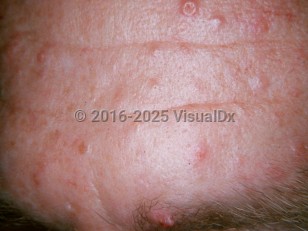Muir-Torre syndrome (MTS) is a subtype of
hereditary nonpolyposis colorectal cancer syndrome (HNPCC;
Lynch syndrome). It is an inherited deficiency in genetic repair mechanisms, including the mismatch repair (MMR) function, which leads to microsatellite instability (MSI). Clinically, this results in a constellation of distinct cutaneous findings and visceral malignancy. Classically, MTS combines at least one sebaceous neoplasm (a
sebaceous adenoma,
sebaceoma, or
sebaceous carcinoma) and at least one visceral malignancy (usually gastrointestinal or genitourinary carcinomas).
Sebaceous gland hyperplasia, a common dermatologic condition, is not considered a part of MTS. Sebaceous neoplasms, including sebaceous adenoma, sebaceoma, and sebaceous carcinoma, however, are the most classic cutaneous manifestations in MTS. When occurring on sites other than the head and neck, these lesions are more commonly associated with MTS compared with nonsyndromic sebaceous neoplasms, which often occur near the eyelid or nose. Of note, in MTS, these skin neoplasms may precede the presentation of visceral malignancy (22% of cases), occur concurrently with visceral malignancy (6% of cases), or occur after the presentation of visceral malignancy (56% of cases), as reported in one study.
Keratoacanthomas are also commonly seen in patients with MTS.
MTS follows an autosomal dominant pattern of inheritance in the majority of cases. One reported subtype of MTS may follow an autosomal recessive pattern. MTS may also occur sporadically or present in transplant recipients or immunocompromised populations. It also has a high degree of penetrance but variable expression. MTS occurs in both sexes, but in the literature, there is a male-to-female ratio of about 3:2. Patients may present at any age, from childhood to old age, but most patients with MTS are discovered in middle age, with a median age of about 50 years.
Clinical diagnostic criteria for MTS include one or more of the following (Mayo Muir-Torre syndrome risk score algorithm). Risk score ranges from 0-5; a risk score of 2 or more has a sensitivity of 100% and specificity of 81% for predicting a germline mutation in MMR genes:
- Younger than 60 years at first diagnosis of sebaceous neoplasm (1 point)
- Presence of one or more sebaceous neoplasms (0 points for one; 2 points if 2 or more)
- Personal history of Lynch-related malignancy (1 point)
- Family history of Lynch-related malignancy (1 point)



